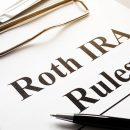How Much Money do you Need for a Comfortable Retirement?

A critical part of retirement planning is to find the right answer to the question – “How much money do I need for a comfortable retirement?” The response differs from person-to-person, and is influenced by current lifestyle and income. According to experts, working adults should ideally have at least 70-80% of their pre-retirement income to support an adequate life after retirement. In contrast to this expectation, according to a report by the Federal Reserve, only 36% of working adults said they were on track with their retirement savings. In such a scenario, how can you determine if you have enough to live a comfortable retirement life?
How to assess if you have enough money for retirement
To assess if you have sufficient money for your non-working years, you must first know the target you are chasing. According to the 70-80% rule, if you currently earn $85,000 per year and the amount is sufficient to support your existing lifestyle, then, you would need between $59,500 and $68,000 per year during retirement.
The 70-80% rule assumes that your expenses in retirement such as, transportation, entertainment, eating out, etc will be comparatively lower than today. It also assumes that your student loans and mortgage payments are paid off, and that you are no longer supporting your children financially.
That said, this method is not the ultimate standard to live by. In case you anticipate your expenses to be more or you expect to travel a lot during retirement, you would need to replace nearly 100% (or more) of your current income. Further, the calculations do not account for your emergency needs or lifelong medical care expenses. Since the cost of healthcare is consistently rising, it is advisable to maintain an emergency fund and invest in Medicare or other insurance policies. As per experts, your emergency corpus should have money equivalent to at least two-three months of your present outlays.
How much do you need to save to achieve your retirement goal?
Once you know your retirement needs, the next step is to identify how to achieve your set target. There are several methods to specify how much you should save. The first is to save at least 20% of your income every month. The savings bar rises each time you get a raise in your earnings.
However, some other experts suggest following the 4% rule. As per this rule, if you limit your annual retirement savings account withdrawals to not more than 4% of your investments, you would have adequate money to support your retirement life. The easy way to apply this rule is to first know your desired retirement income, and then multiply it by 25.
For instance, if your retirement income need is $68,000 per year, then as per the 4% rule, you should save at least $1.7 million ($68,000 * 25). So, by the time you retire, your investment portfolio and overall savings should not be less than $1.7 million to ensure that you have a fully-funded after-work life.
Even though there are objections to the 4% rule, it may still be feasible because it offers an approximate figure. However, if you fear that you need more money during retirement, you should plan to reduce your withdrawal rate and live a more conservative life. One practice that may help is to start saving when you are young. Early savings help unleash the power of compounding. To know when one should begin saving for retirement, use the WiserAdvisor Retirement Calculator which can help you determine how much more you could accumulate at retirement.
SPONSORED WISERADVISOR
What other sources may help to fund your retirement?
The 4% rule adopts a narrow approach and considers only your investment portfolio as the basis to sustain yourself in retirement. However, in reality, you may have additional sources of revenue which can prove beneficial and also reduce the amount you need to save.
The most critical income for retirees is their Social Security benefits. Social Security benefits are monetary support extended to qualified retirees as well as disabled people and their families (including spouse, children, and survivors). To qualify for Social Security benefits, you need to pay into the program during the working years of your life for a minimum period of 10 years (earn 40 credits). Each year you can earn a maximum of four credits. For 2020, one credit is earned for every $1,410 in earnings. For 2021, one credit will amount to $1,470 in earnings. The credit figure is adjusted each year to account for inflation.
According to AARP, for 2020, the average Social Security retirement benefit is approximately $1,503 per month, whereas for people with a disability, the benefit is $1,258 per month. As per the law, you can take Social Security benefits from the age of 62 years. But delaying your withdrawals improves the value of your returns. So, it is best to wait as long as possible before withdrawing your Social Security benefits. According to AARP, an individual who claims Social Security benefits in 2020, can get the following claims per month:
- $3,790 for claims made at the age of 70 years.
- $3,011 for claims made at full official retirement age.
- $2,265 for claims made at the age of 62 years (before official retirement age).
These are the maximum figures for an individual and not for the family.
Additionally, apart from maximizing Social Security benefits to fulfil your retirement needs, you should also take into account additional earnings, if any, from other sources like rental properties. Moreover, it may be easier for you to accommodate your costs if you plan to continue working part-time.
For example, you need $68,000 in retirement, and as per the 4% rule, your investment portfolio should offer savings worth $1.7 million. However, if you know you will have an additional income of $20,000 (from Social Security benefits, or from part-time work, or rental properties), your retirement savings will need to fund only $48,000 instead of $68,000 annually. This in turn, implies that your retirement savings figure should be $1.2 million instead of $1.7 million, which is a significant difference.
Do I need to pay taxes during retirement?
You are liable to pay taxes during your retirement. So, after you know your retirement income, and have an estimate of your savings and other sources of earnings you must account for taxes.
Some tax implications that you must know of are:
- If your only retirement revenue is Social Security benefits, you will not pay any taxes. However, when combined with other earnings like from an IRA (Individual Retirement Account) or a pension plan, taxes are applicable as per the level of income.
- Your pension earnings and pension annuities are taxable.
- Accounts like an IRA, 401(k), 403(b) plans, and 457 plans are exempt from taxes. You will only pay for the gains accrued from these accounts during withdrawal.
To reduce your tax liability, you can choose accounts like a Roth IRA and a Roth 401(k). These accounts offer tax-free savings, receipts, or withdrawals. However, the advantage is applicable if the withdrawal criteria meet the specifications of the Internal Revenue Service (IRS). You can make use of Wiser Advisor’s Investment Return Calculator to know how taxes and inflation will affect you.
To sum it up
Retirement income needs vary per case. However, these standard rules may help to provide a ballpark figure, enabling you to plan and advance in the right direction. You can also make use of Wiser Advisor’s Retirement Calculator to know how much you should save for retirement. In case you require expert guidance, consider engaging a professional financial advisor.
If you have any questions about your retirement planning needs, visit Dash Investments or email me at dash@dashinvestments.com..
About Dash Investments
Dash Investments is privately owned by Jonathan Dash and is an independent investment advisory firm, managing private client accounts for individuals and families across America. As a Registered Investment Advisor (RIA) firm with the SEC, they are fiduciaries who put clients’ interests ahead of everything else.
Dash Investments offers a full range of investment advisory and financial services, which are tailored to each client’s unique needs providing institutional-caliber money management services that are based upon a solid, proven research approach. In addition, each client receives comprehensive financial planning to ensure they are moving toward their financial goals.
CEO & Chief Investment Officer Jonathan Dash has been profiled by The Wall Street Journal, Barron’s, and CNBC as a leader in the investment industry with a track record of creating value for his firm’s clients.











